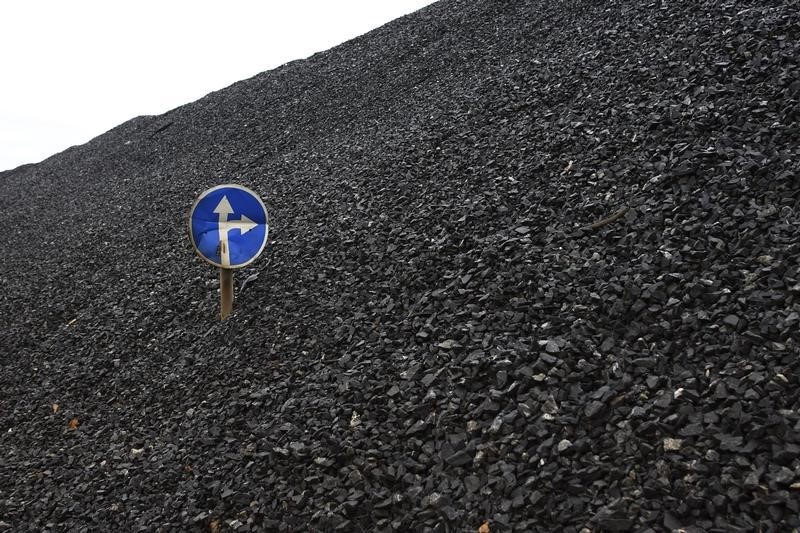--Clyde Russell is a Reuters columnist. The views expressed are his own.--
By Clyde Russell
LAUNCESTON, Australia, Aug 19 (Reuters) - In theory the devaluation of the Chinese yuan should be negative for the country's coal imports and Asian prices, but so far it's not quite panning out that way.
There's nothing wrong with the logic behind the view that purchases of foreign coal by the world's largest importer may decline, given the relative advantage domestic coal has just received from the weakening of the yuan.
The Chinese currency fell about 3 percent in domestic trade last week after it was pushed lower by the People's Bank of China, a move widely interpreted as aiming to boost the competitiveness of the struggling export sector.
It wouldn't have been a surprise if the price of the international coal that heads to China declined in dollar terms, or that the price of domestic coal rose in yuan to reflect the new currency rates.
But Chinese domestic prices remained largely steady, with no change in the benchmark price of thermal coal at Qinhuangdao SH-QHA-TRMCOAL , which held at 410 yuan ($64) a tonne last week.
The domestic price has fallen 22 percent so far in 2015, a drop that has led to more than 70 percent of Chinese coal firms suffering losses in the first half of 2015.
If the yuan depreciation didn't boost domestic coal prices, it didn't do too much to the benchmarks most often used to price imports by China.
The weekly index of thermal coal at Australia's Newcastle port GCLNWCWIDX rose 0.8 percent last week to end at $60 a tonne, which is only slightly below the $61.94 it was in the first week of this year.
In Australian dollar terms, the index gained 6.3 percent from the first week in January to the week to Aug. 14.
However, coal futures traded on ICE have declined, with benchmark Newcastle contracts GCLNWCPFBMc2 losing 5.4 percent from the close on Aug. 10 to Tuesday's close of $58.35 a tonne.
Futures for API8 CRFRMc1 , which assesses coal at cost and freight into southern China, dropped 1.2 percent from the close on Aug. 10 to Tuesday's $50.70 a tonne.
The futures contracts may well be giving a better indication of the likely direction of the physical prices, but even they aren't exactly predicting a sharp drop in coal prices in Asia.
Why is this the case, especially since coal would appear to be the commodity most exposed to a yuan depreciation?
It's possible there are some other factors at work in Asia's coal markets.
MARKET ADJUSTS TO NEW CHINA REALITY
The market is most likely adjusting fairly rapidly to the changing dynamics of China.
It's accepted wisdom that China, as the world's biggest importer, acts as the market balancer for seaborne coal.
The Chinese will always buy cargoes if the price is right, and the right price in this case means one that is lower than the equivalent domestic cost, once freight and other charges are taken into account.
But China's coal imports have ratcheted lower this year, down 33.7 percent in the first seven months to 121.12 million tonnes compared with the same period in 2014.
There are several reasons for that, among them slower demand for thermal power generation, steps by the authorities to limit coal use because of pollution concerns, increased scrutiny and quality checks on imports and improvements in transportation links within China.
While producers in Indonesia, Australia and South Africa will obviously still try to sell to China, it appears they are no longer betting on China to be the consumer of last resort and are adjusting their mining and marketing accordingly.
Indonesian coal output fell 15 percent in the first seven months of the year to 232.9 million tonnes, while exports slumped 18 percent to 186.8 million, the energy ministry said on Aug. 11. ID:nL3N10M2ZO
Australia may claim back the crown of the world's largest exporter of all types of coal from Indonesia as the government forecaster is expecting modest increases in shipments of both coking coal, used in steel-making, and thermal coal in the 2015/16 fiscal year.
The Australian government expects coking coal exports to gain 3 percent in 2015/16, while thermal coal shipments will rise a slight 0.4 percent.
This shows that so far Indonesia is doing the heavy lifting in rebalancing the Asian coal market, but Australia isn't really adding much to increase the current oversupply.
The other heavy lifter in this rebalancing is China itself, with output dropping 3.1 percent in July from a year earlier, and production in the first seven months of 2015 falling 5.3 percent to 2.1 billion tonnes, according to official data. ID:nL3N10N2CZ
This means that in the first seven months of the year Chinese output has dropped by around 100 million tonnes, while Indonesian exports are down around 40 million over the same period.
This has gone a long way towards rebalancing Asian coal markets, but has also reduced the influence of China on the seaborne market.
While it's likely that seaborne coal prices in Asia will have to move lower to reflect the yuan's depreciation, it may not be a dramatic shift.
Coal prices may be influenced more by what happens to India's imports and the rise of consumption in Southeast Asia as new power plants are built.
While the market is still oversupplied, it does appear further down the road of rebalancing than other commodities, such as iron ore, aluminium, copper and crude oil.
(Editing by Alan Raybould)
